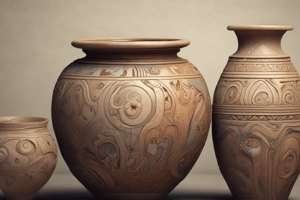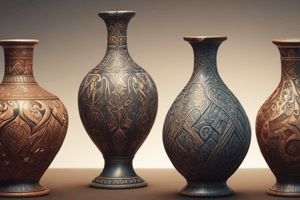Podcast
Questions and Answers
What is pottery?
What is pottery?
- The process of shaping metal objects with heat and tools
- The process of weaving objects with natural fibers and materials, which are then dyed and decorated
- The process of creating objects with wood and other raw materials, which are then carved and polished
- The process of forming vessels and objects with clay and other raw materials, which are then fired at high temperatures for durability (correct)
What are the three traditional types of pottery?
What are the three traditional types of pottery?
- Ceramic, glass, and metal
- Concrete, cement, and plaster
- Plastic, wooden, and paper
- Earthenware, stoneware, and porcelain (correct)
What is the firing temperature range for modern earthenwares?
What is the firing temperature range for modern earthenwares?
- 1,200-1,400°C
- 1,100-1,300°C
- 1,000-1,200°C (correct)
- 800-900°C
What is glazing in pottery?
What is glazing in pottery?
What are some health and environmental issues related to pottery?
What are some health and environmental issues related to pottery?
Where were the earliest-known ceramic objects found?
Where were the earliest-known ceramic objects found?
What was the revolutionizing invention in pottery making in the Fertile Crescent?
What was the revolutionizing invention in pottery making in the Fertile Crescent?
Which ancient culture featured a variety of well-crafted pottery which now included the human form as a decorating motif?
Which ancient culture featured a variety of well-crafted pottery which now included the human form as a decorating motif?
What was the influence of Greek pottery on Etruscan pottery?
What was the influence of Greek pottery on Etruscan pottery?
What is Stoke-on-Trent known as?
What is Stoke-on-Trent known as?
Flashcards are hidden until you start studying
Study Notes
Pottery: The Craft of Making Objects from Clay
-
Pottery is the process of forming vessels and objects with clay and other raw materials, which are then fired at high temperatures for durability.
-
Pottery can be used for tableware, decorative ware, sanitaryware, electrical insulators, and laboratory ware, among other things.
-
Pottery has been practiced since ancient times and is one of the oldest human inventions.
-
Pottery artifacts have been found in various parts of the world, including Jōmon Japan, the Russian Far East, Sub-Saharan Africa, South America, and the Middle East.
-
Pottery is traditionally divided into three types: earthenware, stoneware, and porcelain, and all three may be glazed or unglazed.
-
Earthenware can be fired at low temperatures and is porous, making it unsuitable for storing liquids or tableware.
-
Stoneware is stronger and non-porous to liquids and can be utilitarian or fine art.
-
Porcelain is made by heating materials, including kaolin, at high temperatures, and is known for its translucence, strength, and toughness.
-
Pottery is valuable in archaeology for understanding the culture of past societies, including their technology, tools, trade, and daily life.
-
The study of pottery can also reveal patterns of cross-cultural interaction and societal relationships.
-
The production of pottery involves several stages, including shaping, drying, and firing at appropriate temperatures and atmosphere conditions.
-
The firing temperature for pottery depends on the type of clay and the desired outcome, with modern earthenwares fired at 1,000-1,200°C, stonewares at 1,100-1,300°C, and porcelains at 1,200-1,400°C.A Comprehensive Guide to Pottery: Techniques, History, and Health Concerns
-
Pottery can be created using a variety of methods, but firing in a kiln is the most common method.
-
The maximum temperature and duration of firing influence the final characteristics of the ceramic, and kilns can be heated by burning combustible materials or by electricity.
-
Firing in wood- or coal-fired kilns can introduce smoke, soot, and ash into the kiln, which can affect the appearance of unprotected wares.
-
Pottery is often decorated before or after firing, and there are many methods for glazing, which is a glassy coating on pottery that can be used for decoration, to make the item impermeable to liquids, and to minimize the adherence of pollutants.
-
Health and environmental issues related to pottery include lead poisoning, silicosis, off-site water pollution, air pollution, disposal of hazardous materials, disposal of rejected ware, and fuel consumption.
-
Historically, pottery has been part of past pre-literate cultures, and pottery artifacts and shards survive for millennia at archaeological sites.
-
Pottery may have been discovered independently in various places, probably by accidentally creating it at the bottom of fires on a clay soil.
-
The earliest-known ceramic objects are Gravettian figurines such as those discovered at Dolní Věstonice in the modern-day Czech Republic.
-
Pottery was independently developed in Sub-Saharan Africa during the 10th millennium BC and in South America during the 9,000s-7,000s BC.
-
The earliest pottery vessels found anywhere in the world, dating to 20,000 to 19,000 years before the present, were found at Xianrendong Cave in the Jiangxi province of China.
-
Pottery making began in the 7th millennium BC in the Fertile Crescent and was revolutionized by the invention of the potter's wheel sometime between 6,000 and 4,000 BC.
-
In the Chalcolithic period in Mesopotamia, Halafian pottery achieved a level of technical competence and sophistication not seen until the later developments of Greek pottery with Corinthian and Attic ware.A Brief History of Pottery
-
Pottery was developed in the Neolithic period (circa 8000-4000 BC) in various parts of the world, including the Middle East, Asia, and Europe.
-
The Linear Pottery culture in Europe developed pottery slightly later than the Near East, circa 5500-4500 BC.
-
The ancient Western Mediterranean produced elaborately painted earthenware in the Greek world, and Minoan pottery was characterized by complex painted decoration with natural themes.
-
The classical Greek culture began to emerge around 1000 BC, featuring a variety of well-crafted pottery which now included the human form as a decorating motif.
-
Fine Etruscan pottery was heavily influenced by Greek pottery, and ancient Roman pottery made much less use of painting, but used molded decoration, allowing industrialized production on a huge scale.
-
Pottery was hardly seen on the tables of elites from Hellenistic times until the Renaissance, and most medieval wares were coarse and utilitarian.
-
The city of Stoke-on-Trent is widely known as "The Potteries" because of the large number of pottery factories or "Pot Banks."
-
Early Islamic pottery followed the forms of the regions which the Muslims conquered; however, there was cross-fertilization between the regions, especially in the Chinese influences on Islamic pottery.
-
Most evidence points to an independent development of pottery in the Native American cultures, with the earliest known dates from Brazil, from 9,500 to 5,000 years ago and 7,000 to 6,000 years ago.
-
Evidence indicates an independent invention of pottery in Sub-Saharan Africa, with pottery dating back to at least 9,400 BC.
-
Pottery has been found in archaeological sites across the islands of Oceania, attributed to an ancient archaeological culture called the Lapita.
-
The Indigenous Australians never developed pottery, but after Europeans came to Australia and settled, they found deposits of clay which were analyzed by English potters as excellent for making pottery.
Studying That Suits You
Use AI to generate personalized quizzes and flashcards to suit your learning preferences.





